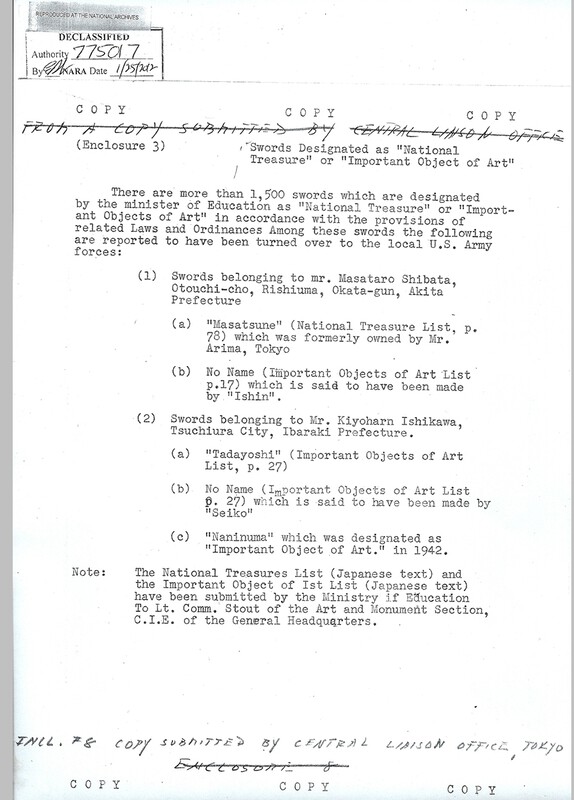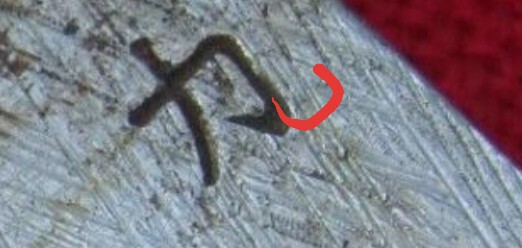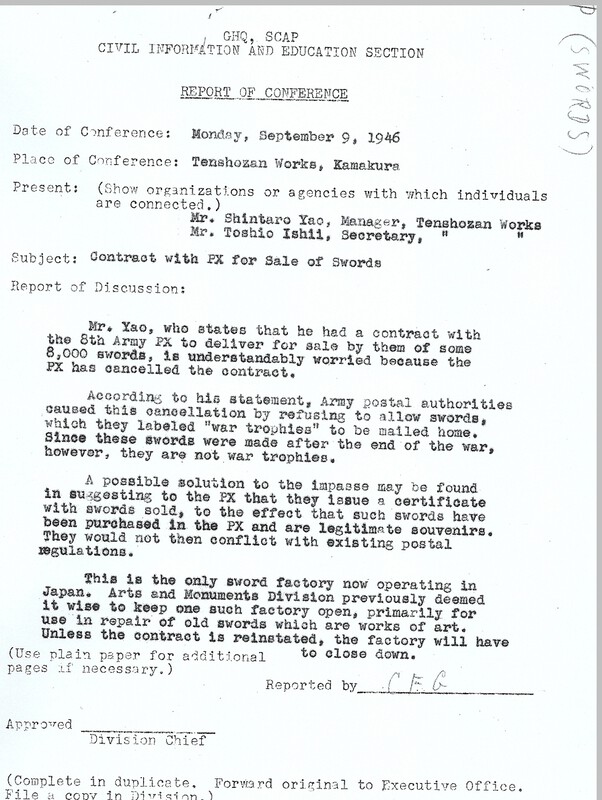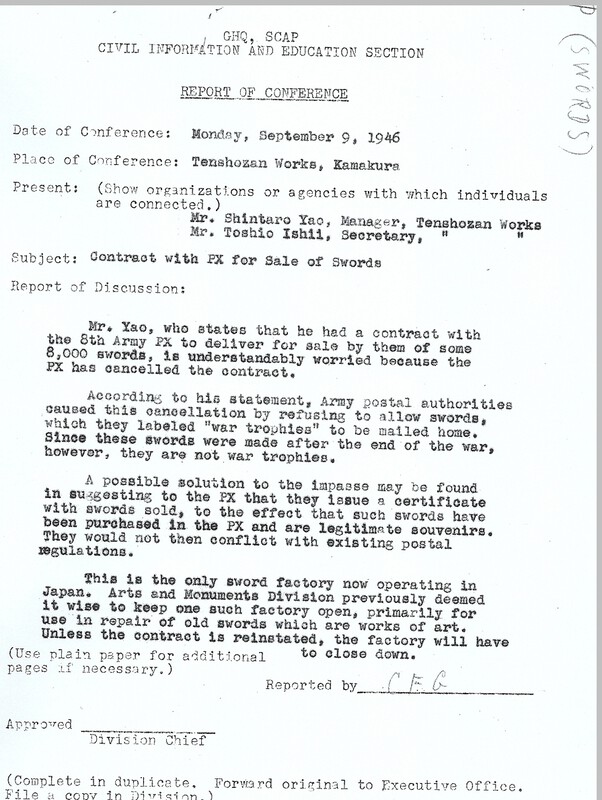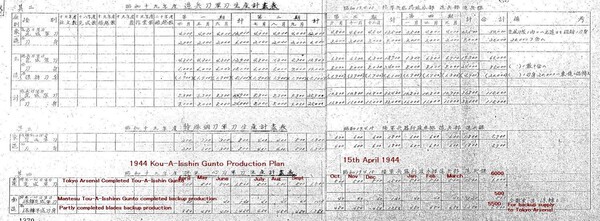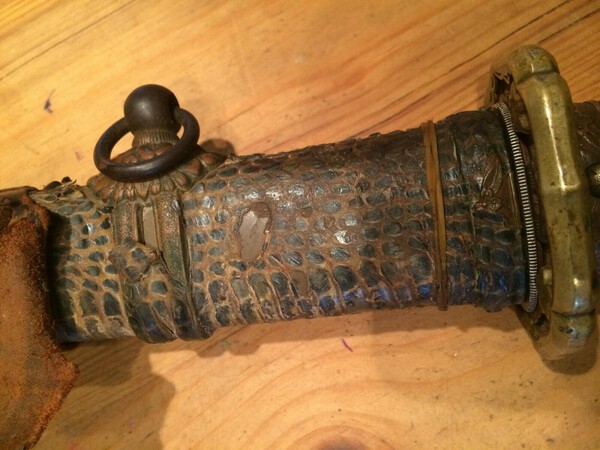-
Posts
13,000 -
Joined
-
Last visited
-
Days Won
155
Content Type
Profiles
Forums
Events
Store
Downloads
Gallery
Everything posted by Bruce Pennington
-

Koa Isshin With Nthk Papers
Bruce Pennington replied to PNSSHOGUN's topic in Military Swords of Japan
Rats, what a killjoy! Couldn’t even enjoy my fantasy for 24 hours. -

Nlf Gunto Discussion
Bruce Pennington replied to Bruce Pennington's topic in Military Swords of Japan
Chris, The document states that the 8th Army PX had contracted "for some 8,000 swords." -

Koa Isshin With Nthk Papers
Bruce Pennington replied to PNSSHOGUN's topic in Military Swords of Japan
Here's some food for thought. A document from right after the war, discussing swords classified as national treasures and works of art. Paragraph 1.b. lists a sword without signature but said to be made by a guy named "Isshin"! Ha! So, a Japanese official actually listed the Koa Isshin as an important work of art!? Hmmmmm. This comes from the Articles section: http://www.militaria.co.za/nmb/forum/57-nt-and-iao-list-and-sword-documents-by-us-gov-1945-1950/ -
-

Nlf Gunto Discussion
Bruce Pennington replied to Bruce Pennington's topic in Military Swords of Japan
That's the way it looks. -

Nlf Gunto Discussion
Bruce Pennington replied to Bruce Pennington's topic in Military Swords of Japan
Here is the document. It shows the Tenshozan factory was the only factory allowed to remain open and was making these swords. -

Matching Mystery Marine Mounton Ebay
Bruce Pennington replied to Johncstroud's topic in Military Swords of Japan
Here is the document. It states that the Tenshozan factory is the only one allowed to remain open after the war and was making these "swords". I don't know if they were just making the blades and Japan Sword was doing the rest. It doesn't say. -

Nlf Gunto Discussion
Bruce Pennington replied to Bruce Pennington's topic in Military Swords of Japan
Copying something provided by Ian on another thread: Ian B3HR2UH Jo Saku Members 120 posts Locationdrouin australia Posted Yesterday, 11:26 PM There are a few documents around that I think explain what these swords are Among the fantastic documents that Stephen Thorpe kindly posted in the articles section is the report of a conference held at the Tenshozan Works Kamakura on the 9th of September 1946. Those present included the manager Shintaro Yao who said that he had a contract with the 8th Army PX to deliver for sale by them 8000 swords . He was worried because the PX had cancelled the contract. Among the downloadable documents in the National Diet library website is a letter from Capt Wall dated 22 July 1949 where he seeks permission to take home one Naval type Japanese sword presented to him by Mr Yao supervisor of the Japanese Naval sword Manufacturing Co Kamakura . There is a further letter dated 4 March 1950 requesting authorization to procure authentic samurai swords and hari kari knives for resale to the Exchange . I am not sure what the exchange is but the letter goes on to approve the recommendation that CPO be allowed to procure for sale to the exchange some 6000 souvenir swords . It was noted that the recommendation was based on the fact that an original purchase order had been placed with the manufacturer and had not been cancelled in time to prevent the manufacture of some 6000 swords. In order to prevent monetary loss to the Japanese concern procurement of the remainder of the purchase order was approved . I think these documents explain the origins of these swords Ian Brooks -

Matching Mystery Marine Mounton Ebay
Bruce Pennington replied to Johncstroud's topic in Military Swords of Japan
That's great information Ian! It confirms what I had found. Over on Gunboards someone posted one of these with the Army PX document. It written out by the 8th Army Exchange and says it's a souvenir not a war weapon. By all appearances, it was sold by the PX! I think these were being made as part of MacArthur's post-war effort to keep businesses running. You can see more of it on this thread: http://www.militaria.co.za/nmb/topic/22400-nlf-gunto-discussion/page-1?hl=gunto and http://www.wehrmacht...ad.php?t=984036 -
I couldn't get mine to unscrew. Something under the sakura hangs up on the wire wrap. I'm afraid if I force it, it will break the wire. Oh well, it's a factory blade anyway.
-
Trystan, Do you have the smith name on that blade? I have in my files another kai with the identical styled Toyokawa stamp and it, too, has a kanji stamped below the arsenal stamp. It is the first kanji of the smith that made it. Could this be what we are seeing on yours?
-
That's a new one on me, Trystan! Katakana "Ka". Thomas - do you have this one on your document?
-

Attention Mantetsu Owners: A Survey
Bruce Pennington replied to Bruce Pennington's topic in Military Swords of Japan
Well, most factory-made products were, and still are, numbered. Bayonets, guns, etc, all had numbers. Don’t know why factories do it though. There were a small number of smiths that numbered their blades. -

Attention Mantetsu Owners: A Survey
Bruce Pennington replied to Bruce Pennington's topic in Military Swords of Japan
I would still like to hear Morita-san's thoughts on why the school kids kept records of the serial numbers they polished, and a clarification as to how certain we are the blades were actually produced at Mukden. I've attached the updated document (4.0) which includes these new numbers and I've attached the chart showing the serial number flow using the iroha method. mantetsu serial numbers (1).pdf -

Attention Mantetsu Owners: A Survey
Bruce Pennington replied to Bruce Pennington's topic in Military Swords of Japan
Trystan, I see it now, thanks! This would also clear up my question about how many blades were being produced per year. Serial numbers in this range would still fit the 6,000/year number. The '45s are: I 57, 90, 213, 289, and 449. -

Attention Mantetsu Owners: A Survey
Bruce Pennington replied to Bruce Pennington's topic in Military Swords of Japan
Oh My Gosh! What a significant find! It's amazing that you even found such a book. So, this confirms that Mantetsu blades were being made in the Mukden armory, and that the Konan-essei slogan on blades was real. I backs up the actual blade we have, both in slogan and in serial number as as a faker would not have know that "I" was the katakana of 1945. By the span of serial numbers, it shows that many were made that year (at least 1189). I have a question about the 1944 numbers: If I am reading them right, there are 5-digit numbers? Se 11596, 11151,11193, 11767, and the last one is confusing as it looks like 11(upside-down 2)15 or is it a poorly written 1135? What do you make of the 4 and 5 digit numbers Morita-san? The highest output I've read about is 400 per month (4,800 blades per year), but with Nick Komiya's 1944 document ordering Mantetsu to produce 6,000 unfinished blades for the Tokyo arsenal, PLUS these very high serial numbers, it appears Mantetsu was making considerably more blades than 4,800 per year. What do you think? I've attached the document Nick Komiya found. It seems to say that there were 6,500 Koa Isshins to be produced in 1944 (5,500 unfinished blades to go to Tokyo arsenal). That would make the 5-digit numbers seem odd. Sorry for so many questions! But why is it, do you think, that high school kids would have kept the serial numbers of the blades they polished? I don't doubt that they did, but why would they? Thank you so much for the new info, this is fantastic! PS: Another question- You said this confirms that Mukden was making Mantetsu blades. Does the book state that? Or were you infering that because the kids were polishing blades there? I ask because of the document Nick Komiya found ordering unfinished blades for the Tokyo factory to finish. If SMR was doing that for Tokyo, it is possible they were doing it for Mukden too. So it would be important to know, from the book, if they were saying that Mukden was making the blades, not just finishing them. Thank you again! -

A look at the Japanese Imperial Household Dirk
Bruce Pennington replied to matthewbrice's topic in Military Swords of Japan
For those not on Warrelics, I thought I'd post this link. Nick Komiya uncovered a document about non-standardized Navy Police Dirks. Prior to 1891, when the standard was set, they were up to personal taste and designs varied greatly. The post originator shows one that seemed to have a navy dirk in a police saya, but there were things not right about the saya, too. Nick found out why! http://www.warrelics.eu/forum/Japanese-militaria/unknown-Japanese-dirk-745042/ A shot of the dirk: -
I totally missed the "Ikko" part of Guy's translation of that newspaper ad. That is too strong of a coincidence! I have seen other stamps where it is the first kanji of a name ("伊” the first character of the name of sword smith 伊奈波兼吉(Inaba Kaneyoshi) comes to mind) or Fuku for Fukuoka. And considering the fact that there are no other known sword makers that were involved in the Type 95 process, the evidence is definitely leaning to "K" for Kobe and "一" for Ikko. Why the switch would be great to find out. On the Gifu to Seki discussion - I have read that the Seki group abandonded the "Seki" stamp when the Nagoya Arsenal started using it, so I had assumed the order to have flowed in the other direction: Seki ---> Gifu. It would take some investigating to see some dates on blades bearing both stamps to pin it down.
-
Nice examples, Steve, thanks!
-
Snakeskin is quite different, see the pic below. Hard to date a tsuba. There is a "late-war" canvas found in late-war navy tsuba, but not all tsuba made at the end of the war had them.
-
Perfect Ernie, thanks!!! Added to the Stamps Doc.
-
It’s rayskin like me the army. Navy simply laquered It black.
-
Well shoot. With my bad eyes and those original pics, I mistook the "0" for a shop stamp. Sorry, but much better pics, BTW! I can see what you mean about the original black tsuba being overcoated with the copper finish. Odd.
-
It’s nothing special Austus. I just collect stamps and am curious about the one on your fittings.
-

What's the most you spent on a sword?
Bruce Pennington replied to piryohae3's topic in General Nihonto Related Discussion
The most I've spent is $2,400 (twice). One for a copper-handled Type 95 and another for a Kaigunto with a koto blade and rayskin saya. But I've got a pretty small hobby fund.



